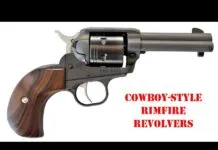The basic concept of the .357 SIG is to deliver the same stopping power of the feared and respected .357 Magnum revolver cartridge from a semi-automatic pistol. The .357 Magnum round, featuring a 125-grain bullet fired from a 4-inch duty revolver, is widely recognized to be a top-flight fight stopper. Unfortunately, the recoil and flash of this combination also has few equals.
Power and controllability have long been issues in pistol cartridges, as witnessed by the love/hate affair with 9mm rounds. Handgunners love to shoot the soft-kicking 9mm, but they don’t have confidence in the 9mm’s one-shot stopping power. A compromise has been to cram as many rounds in the handle as possible, essentially trading high capacity for power.
The .357 SIG cartridge seeks to split the difference, offering the smaller rim diameter of a 9mm with nearly the punch of a .40 S&W. The Hodgdon No. 27 reloading manual says, “The .357 SIG is the .40 S&W case necked down to 9mm and effectively duplicates the .38 Super.”
But even the best round in a sorry pistol package would be of no use to anyone, so we went a-searching for handguns that could fire the .357 SIG effectively.
Glock adapted this same pistol to other cartridges, including the .357 SIG, and we found the fully loaded GL31 handled much like the model 17. If you have ever felt that the Glock pistol chambered for .45 ACP or 180-grain .40s were somehow out of sync, then the .357 SIG is a more natural fit.
From the standpoint of recoil, however, the loss of gross weight could be seen as a detriment. Even in the full-size GL31, the shooter becomes aware that he has just launched a hefty round. But because the projectile is light, the recoil pulse is over quickly, and the recoil is predictable. In particular, due to reduced bearing surface of the bullet traveling through the barrel, the shooter feels little torque when he fires the gun. Also, with the amount of propellant inside the oversized case, velocity is high and the bullet spends little time inside the barrel.
In fact, the GL31 produced the highest velocity overall, firing the Federal Premium 125-grain JHP at an average velocity of 1,364 fps. The Speer Gold Dot Hollowpoints (GDHP) rounds averaged a tick behind at 1,358 fps. The Winchester round-nosed flat points described as target or training ammunition averaged a whopping 1,336 fps. That means muzzle energy ranged from 496 to 517 foot-pounds.
To put this into perspective, the muzzle energy generated by some previously tested pistols in .45 ACP ranged from 276 foot-pounds (Winchester 185-grain full metal jackets) to 331 foot-pounds firing the Winchester 185-grain SilverTip HP. In another test, Winchester’s .40 S&W 180-grain FMJ produced about 400 foot-pounds. Returning to our lineup of .357 SIG pistols, even the small GL33 easily eclipsed these marks.
Obviously, power out the muzzle isn’t an issue with the .357 SIG, but how does that oomph register behind the gun? We found that working from a rest or standing, the GL31 is the easiest of the Glocks to shoot. There is plenty of frame to rest on a sandbag and the gun offers 6.5 inches of sight radius. Felt recoil is sharper than with other calibers, but in this case the force is expressed directly rearward, not as muzzle flip. We theorize that since more of the energy is coming straight back into the hand, instead of torquing upward, the impact of the recoil seems greater. Working from a rest, for example, it is the wrist that takes a beating. This is because the recoil has nowhere to go but up.
In testing the Glock pistols, we felt the increased kick from this high-pressure round, but we didn’t think the wrist fatigue was overwhelming. However, we did feel more impact as the gun sat back into the hand. A firm grip with a focused intent is needed to fire the Glock .357 SIG pistols effectively.
The GL31 proved the least objectionable to shoot and also produced the most accuracy. While five-shot groups averaged a respectable 2.4-inch diameter with the Winchester FMJ rounds, the GL31’s performance with the hollowpoints were exceptional. The Federal shot the smallest single group (1.2 inches), but what impressed us more was the performance of the Speer 125-grain GDHP round, varying only 0.1 inch across the groups for an average of 1.9 inches.


























